9.3: Leaf Anatomy
- Page ID
- 29556
\( \newcommand{\vecs}[1]{\overset { \scriptstyle \rightharpoonup} {\mathbf{#1}} } \)
\( \newcommand{\vecd}[1]{\overset{-\!-\!\rightharpoonup}{\vphantom{a}\smash {#1}}} \)
\( \newcommand{\dsum}{\displaystyle\sum\limits} \)
\( \newcommand{\dint}{\displaystyle\int\limits} \)
\( \newcommand{\dlim}{\displaystyle\lim\limits} \)
\( \newcommand{\id}{\mathrm{id}}\) \( \newcommand{\Span}{\mathrm{span}}\)
( \newcommand{\kernel}{\mathrm{null}\,}\) \( \newcommand{\range}{\mathrm{range}\,}\)
\( \newcommand{\RealPart}{\mathrm{Re}}\) \( \newcommand{\ImaginaryPart}{\mathrm{Im}}\)
\( \newcommand{\Argument}{\mathrm{Arg}}\) \( \newcommand{\norm}[1]{\| #1 \|}\)
\( \newcommand{\inner}[2]{\langle #1, #2 \rangle}\)
\( \newcommand{\Span}{\mathrm{span}}\)
\( \newcommand{\id}{\mathrm{id}}\)
\( \newcommand{\Span}{\mathrm{span}}\)
\( \newcommand{\kernel}{\mathrm{null}\,}\)
\( \newcommand{\range}{\mathrm{range}\,}\)
\( \newcommand{\RealPart}{\mathrm{Re}}\)
\( \newcommand{\ImaginaryPart}{\mathrm{Im}}\)
\( \newcommand{\Argument}{\mathrm{Arg}}\)
\( \newcommand{\norm}[1]{\| #1 \|}\)
\( \newcommand{\inner}[2]{\langle #1, #2 \rangle}\)
\( \newcommand{\Span}{\mathrm{span}}\) \( \newcommand{\AA}{\unicode[.8,0]{x212B}}\)
\( \newcommand{\vectorA}[1]{\vec{#1}} % arrow\)
\( \newcommand{\vectorAt}[1]{\vec{\text{#1}}} % arrow\)
\( \newcommand{\vectorB}[1]{\overset { \scriptstyle \rightharpoonup} {\mathbf{#1}} } \)
\( \newcommand{\vectorC}[1]{\textbf{#1}} \)
\( \newcommand{\vectorD}[1]{\overrightarrow{#1}} \)
\( \newcommand{\vectorDt}[1]{\overrightarrow{\text{#1}}} \)
\( \newcommand{\vectE}[1]{\overset{-\!-\!\rightharpoonup}{\vphantom{a}\smash{\mathbf {#1}}}} \)
\( \newcommand{\vecs}[1]{\overset { \scriptstyle \rightharpoonup} {\mathbf{#1}} } \)
\( \newcommand{\vecd}[1]{\overset{-\!-\!\rightharpoonup}{\vphantom{a}\smash {#1}}} \)
\(\newcommand{\avec}{\mathbf a}\) \(\newcommand{\bvec}{\mathbf b}\) \(\newcommand{\cvec}{\mathbf c}\) \(\newcommand{\dvec}{\mathbf d}\) \(\newcommand{\dtil}{\widetilde{\mathbf d}}\) \(\newcommand{\evec}{\mathbf e}\) \(\newcommand{\fvec}{\mathbf f}\) \(\newcommand{\nvec}{\mathbf n}\) \(\newcommand{\pvec}{\mathbf p}\) \(\newcommand{\qvec}{\mathbf q}\) \(\newcommand{\svec}{\mathbf s}\) \(\newcommand{\tvec}{\mathbf t}\) \(\newcommand{\uvec}{\mathbf u}\) \(\newcommand{\vvec}{\mathbf v}\) \(\newcommand{\wvec}{\mathbf w}\) \(\newcommand{\xvec}{\mathbf x}\) \(\newcommand{\yvec}{\mathbf y}\) \(\newcommand{\zvec}{\mathbf z}\) \(\newcommand{\rvec}{\mathbf r}\) \(\newcommand{\mvec}{\mathbf m}\) \(\newcommand{\zerovec}{\mathbf 0}\) \(\newcommand{\onevec}{\mathbf 1}\) \(\newcommand{\real}{\mathbb R}\) \(\newcommand{\twovec}[2]{\left[\begin{array}{r}#1 \\ #2 \end{array}\right]}\) \(\newcommand{\ctwovec}[2]{\left[\begin{array}{c}#1 \\ #2 \end{array}\right]}\) \(\newcommand{\threevec}[3]{\left[\begin{array}{r}#1 \\ #2 \\ #3 \end{array}\right]}\) \(\newcommand{\cthreevec}[3]{\left[\begin{array}{c}#1 \\ #2 \\ #3 \end{array}\right]}\) \(\newcommand{\fourvec}[4]{\left[\begin{array}{r}#1 \\ #2 \\ #3 \\ #4 \end{array}\right]}\) \(\newcommand{\cfourvec}[4]{\left[\begin{array}{c}#1 \\ #2 \\ #3 \\ #4 \end{array}\right]}\) \(\newcommand{\fivevec}[5]{\left[\begin{array}{r}#1 \\ #2 \\ #3 \\ #4 \\ #5 \\ \end{array}\right]}\) \(\newcommand{\cfivevec}[5]{\left[\begin{array}{c}#1 \\ #2 \\ #3 \\ #4 \\ #5 \\ \end{array}\right]}\) \(\newcommand{\mattwo}[4]{\left[\begin{array}{rr}#1 \amp #2 \\ #3 \amp #4 \\ \end{array}\right]}\) \(\newcommand{\laspan}[1]{\text{Span}\{#1\}}\) \(\newcommand{\bcal}{\cal B}\) \(\newcommand{\ccal}{\cal C}\) \(\newcommand{\scal}{\cal S}\) \(\newcommand{\wcal}{\cal W}\) \(\newcommand{\ecal}{\cal E}\) \(\newcommand{\coords}[2]{\left\{#1\right\}_{#2}}\) \(\newcommand{\gray}[1]{\color{gray}{#1}}\) \(\newcommand{\lgray}[1]{\color{lightgray}{#1}}\) \(\newcommand{\rank}{\operatorname{rank}}\) \(\newcommand{\row}{\text{Row}}\) \(\newcommand{\col}{\text{Col}}\) \(\renewcommand{\row}{\text{Row}}\) \(\newcommand{\nul}{\text{Nul}}\) \(\newcommand{\var}{\text{Var}}\) \(\newcommand{\corr}{\text{corr}}\) \(\newcommand{\len}[1]{\left|#1\right|}\) \(\newcommand{\bbar}{\overline{\bvec}}\) \(\newcommand{\bhat}{\widehat{\bvec}}\) \(\newcommand{\bperp}{\bvec^\perp}\) \(\newcommand{\xhat}{\widehat{\xvec}}\) \(\newcommand{\vhat}{\widehat{\vvec}}\) \(\newcommand{\uhat}{\widehat{\uvec}}\) \(\newcommand{\what}{\widehat{\wvec}}\) \(\newcommand{\Sighat}{\widehat{\Sigma}}\) \(\newcommand{\lt}{<}\) \(\newcommand{\gt}{>}\) \(\newcommand{\amp}{&}\) \(\definecolor{fillinmathshade}{gray}{0.9}\)Mesophytic Leaf Anatomy
View a prepared slide of a Ranunculus leaf. This small, herbaceous flowering plant is more commonly referred to as a buttercup. It grows in many environments, but tends to prefer shaded, cool spots with plenty of moisture. It is a good example of a "standard" leaf, not specially adapted to either wet or dry environments. This type of plant is called a mesophyte (meso- meaning middle, -phyte meaning plant), preferring moderate climatic conditions.
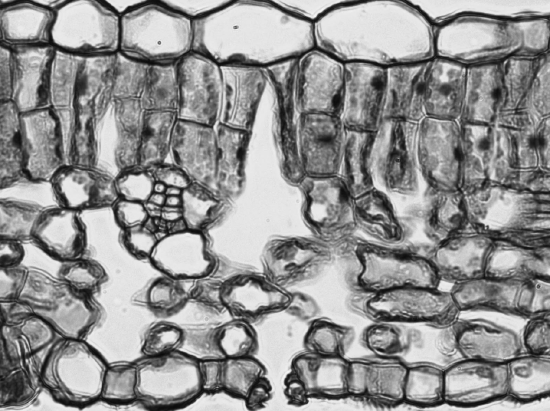
The outer layer of cells on both the upper and lower surface of the leaf is the epidermis. Can you find any pores (gaps) in the epidermis? These pores are called stomata and allow carbon dioxide (\(\ce{CO2}\)) to enter the leaf for photosynthesis. Oxygen (\(\ce{O2}\)), which is produced during photosynthesis as a waste product, is released through the stomata. A third gas, water vapor (\(\ce{H2O}\)), also escapes through the stomata, though this has both beneficial and detrimental effects for the plant.
Look to either side of a stoma (this is the singular version of stomata) to see the flanking guard cells. These cells regulate the opening and closing of the stoma by either inflating and opening when there is high water content in the leaf, or collapsing and closing the stoma when water content in the leaf is low. This prevents water vapor from escaping the plant if it has too little water. However, it also prevents \(\ce{CO2}\) from entering, stopping the formation of sugars in the plant and cutting of its source of energy. The flow of water vapor out of the leaf helps pull water up from the roots, see lab 5a for a full description of transpiration.
Beneath the upper epidermis is a layer of elongated cells full of chloroplasts. This is the palisade mesophyll, which has specialized for capturing incoming sunlight, rotating chloroplasts to the top of the leaf and then allowing them to regenerate by cycling them toward the leaf's center. Just below the palisade mesophyll is the spongy mesophyll. The spongy mesophyll is full of air pockets (hence the name spongy) that allow \(\ce{CO2}\) to move into the leaf to the palisade mesophyll, as well as allowing oxygen to diffuse from the palisade mesophyll through the spongy mesophyll and out the stomata.
You may see circles of densely packed cells that both stain a different color than the mesophyll cells, as well as have a different organizational structure. These are veins of vascular tissue running through the leaf. The xylem is on the top, staining differently from the rest of the cells due to its lignified secondary walls. The phloem is on the bottom of the bundle, supported by a cluster of fibers (sclerenchyma) that increase structural support for the veins. The xylem is transporting water and dissolved minerals from the roots up to the leaf, while the phloem is transporting sugars made in the leaf to other regions of the plant.
Draw a cross section of a mesophytic leaf, labeling each structure or tissue with its name and function. Consider simplifying the image to use as an easy reference.
In the leaf you are viewing, are there more stomata on the upper or lower epidermis? Can you think of any reasons why this might be?
How does the structure of the spongy mesophyll contribute to its function?
Hydrophytic Leaf Adaptations
Hydrophytes (hydro- meaning water) are plants adapted to growing in water. The structure of a hydrophytic leaf differs from a mesophytic leaf due to selective pressures in the environment -- water is plentiful, so the plant is more concerned with staying afloat and preventing herbivory.
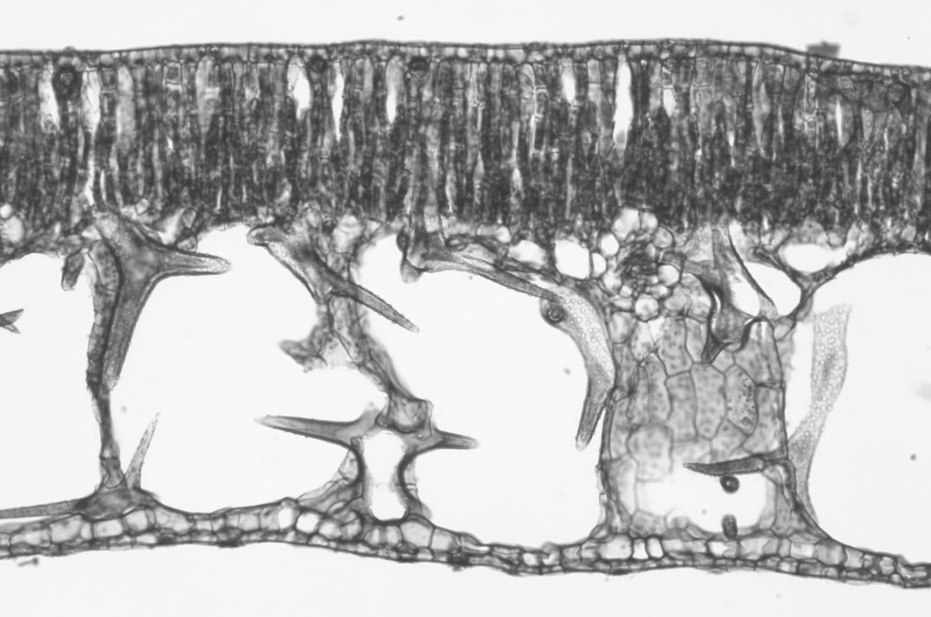
Observe a prepared slide of a hydrophyte, such as Nymphaea, commonly called a water lily. Note the thin epidermal layer and the absence of stomata in the lower epidermis. In the spongy mesophyll, there are large pockets where air can be trapped. This type of parenchyma tissue, specialized for trapping gases, is called aerenchyma. Look for sharp-looking, branched cells traversing the leaf’s mesophyll. These will stain differently from the parenchyma cells because they have a thick secondary wall. These sclerenchyma cells are called astrosclereids and provide the leaf structural support, as well as prevention of herbivory.
Why are there no stomata on the lower epidermis of a Nymphaea leaf?
Draw a cross section of the Nymphaea leaf, labeling each structure or tissue with its name and function.
Xerophytic Leaf Adaptations
Xerophytic (xero- meaning dry) plants are adapted to dry conditions. California is a great place to view xerophytic plants due to the long dry season that also corresponds to the warmest season. If you are from California, this may seem perfectly normal. However, in most other places, the warm season coincides with the wet season, a much easier climate for plants to navigate. The coincidence of dry and warm seasons occurs in 5 distinct regions of the world, all on the west coast of their continent and all in a narrow latitudinal band between 30-60 degrees on either side of the equator. This type of climate is named after one of these 5 regions -- the Mediterranean.
Warm to hot temperatures cause increased transpiration. Dry conditions have the same effect, doubling the water stress on plants in Mediterranean climates where it is both warm and dry at the same time.
Pines
Pines evolved during a period in Earth’s history when conditions were becoming increasingly dry. Pine needles have many adaptations to deal with these conditions.
- The epidermis of the leaf seems to be more than one cell layer thick. These subsequent layers of epidermis-like tissue under the single, outer layer of true epidermis are called the hypodermis (hypo- meaning under, dermis meaning skin), which offers a thicker barrier and helps prevent water loss.
- The epidermis itself is coated on the outside by a thick layer of wax called the cuticle. Because waxes are hydrophobic, this also helps prevent water loss through the epidermis.
- The stomata are typically sunken, occurring within the hypodermis instead of the epidermis. Sunken stomata create a pocket of air that is protected from the airflow across the leaf and can aid in maintaining a higher moisture content.
- There are two bundles of vascular tissue embedded within a region of cells called transfusion tissue. The transfusion tissue and vascular bundles are surrounded by a distinct layer of cells called the endodermis (much like in a root, but not suberized).
- Finally, the overall shape of the leaf allows for as little water loss as possible by decreasing the relative surface area, taking a rounder shape as opposed to a flatter one. This low surface area to volume ratio is characteristic of xerophytes.
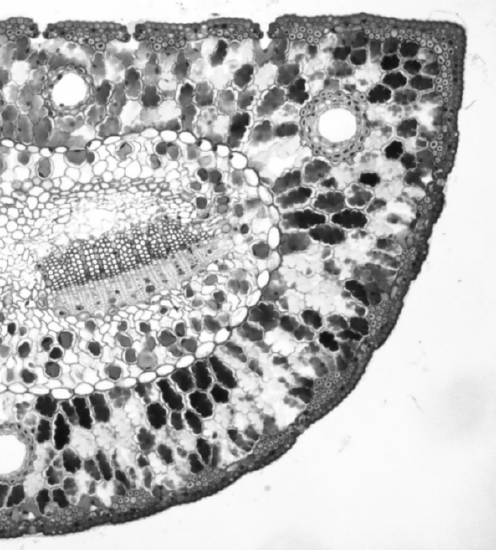
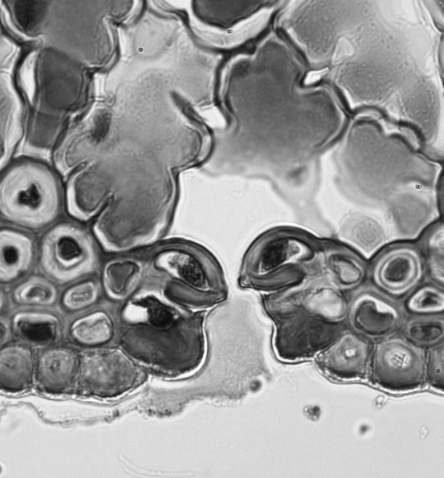
Observe a prepared slide of a pine needle cross section. The strange, invaginated cells between the hypodermis and the endodermis are the mesophyll. Draw in the other half of the pine needle above. Identify and label the structures involved in water retention.
Note
There are several canals that appear as large, open circles in the cross section of the leaf. These are resin canals. The cells lining them secrete resin (the sticky stuff that coniferous trees exude, often called pitch), which contains compounds that are toxic to insects and bacteria. When pines evolved, not only was the Earth becoming drier, but insects were evolving and proliferating. These resin canals are not features that help the plant survive dry conditions, but they do help prevent herbivory. In addition to prevention of herbivory, resin can aid in closing wounds and preventing infection at wound sites.
Oleander
Oleander (Nerium oleander) is another plant that has specifically adapted to survive drought conditions, possibly native to the Mediterranean though its precise origin is unknown. Oleander also has defenses against herbivory, making the entire plant extremely toxic, even to humans.
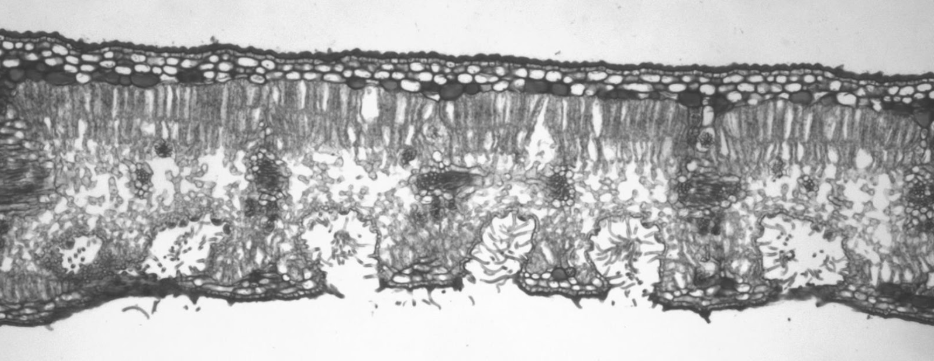
Instead of sunken stomata, the epidermis in oleander recesses and creates a pocket that is lined with trichomes. The stomata are located at the base of these pockets, called stomatal crypts. The trichomes help capture evaporating moisture and maintain a relatively humid environment around the stomata. These stomatal crypts are located only on the underside of the leaves, where they experience less sun exposure and therefore less transpiration. The upper epidermis is free from stomata and, instead, is coated by a thick cuticle.
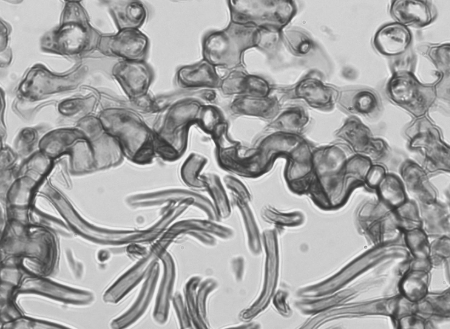
The image below shows a close-up of the upper epidermis. What is that thick layer on top of the epidermis? How does it compare to the same layer in a mesophytic leaf?
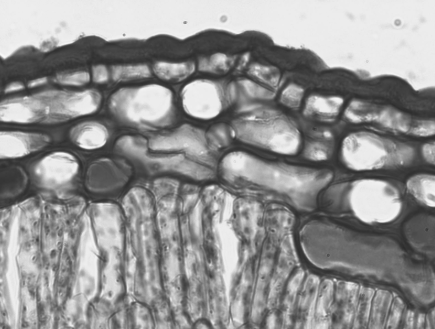
Observe a prepared slide of a cross section of a Nerium leaf. Draw and label the structures mentioned in the paragraph above, as well as any additional features you see from the description of xerophytic adaptations in pines.
Which adaptations do pines and oleander share? Which features found in the pine leaf are absent in the oleander leaf?
Corn
Corn (Zea mays) is not necessarily a xerophyte, but it is adapted to deal with high temperatures. One of these adaptations, C4 type photosynthesis, will be covered in the photosynthesis lab. The one you will identify is something that lets the leaf alter the amount of exposed surface area. When moisture is plentiful, the corn leaves are fully expanded and able to maximize photosynthesis. When moisture is limited, the leaves roll inward, limiting both moisture loss and photosynthetic capacity. This is accomplished by the presence of bulliform cells in the upper epidermis. These clusters of enlarged cells are swollen with water when there is abundant water available. As the water content in the plant decreases, these cells shrivel, causing the upper epidermis to curl or fold inward at these points. This adaptation to sun exposure can be found in many other grasses, as well (corn is a member of the Poaceae, the grass family).
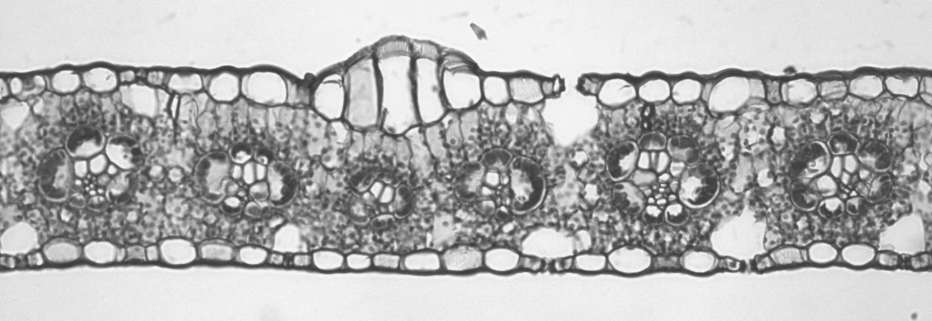
Observe a prepared slide of a cross section of a Zea mays leaf. Look for clusters of enlarged cells in the upper epidermis. Label the bulliform cells in the image above.
Why aren’t there bulliform cells in the lower epidermis as well? What would happen to a leaf with bulliform cells on both sides?
Where are the stomata located on a leaf of Zea mays?


